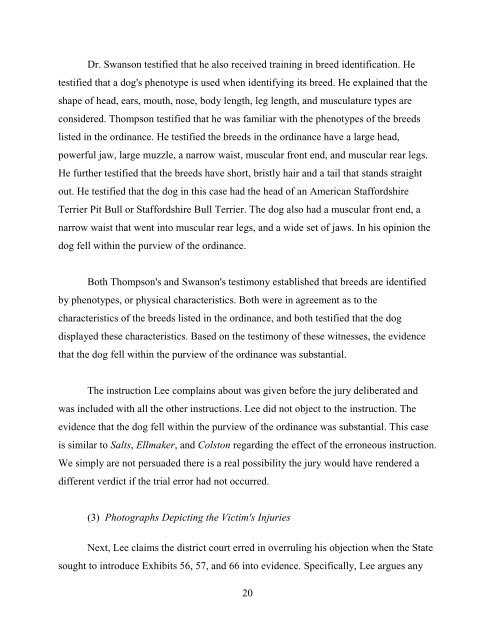Kansas Court of Appeals - 102004 â State v. Lee
Kansas Court of Appeals - 102004 â State v. Lee
Kansas Court of Appeals - 102004 â State v. Lee
Create successful ePaper yourself
Turn your PDF publications into a flip-book with our unique Google optimized e-Paper software.
Dr. Swanson testified that he also received training in breed identification. He<br />
testified that a dog's phenotype is used when identifying its breed. He explained that the<br />
shape <strong>of</strong> head, ears, mouth, nose, body length, leg length, and musculature types are<br />
considered. Thompson testified that he was familiar with the phenotypes <strong>of</strong> the breeds<br />
listed in the ordinance. He testified the breeds in the ordinance have a large head,<br />
powerful jaw, large muzzle, a narrow waist, muscular front end, and muscular rear legs.<br />
He further testified that the breeds have short, bristly hair and a tail that stands straight<br />
out. He testified that the dog in this case had the head <strong>of</strong> an American Staffordshire<br />
Terrier Pit Bull or Staffordshire Bull Terrier. The dog also had a muscular front end, a<br />
narrow waist that went into muscular rear legs, and a wide set <strong>of</strong> jaws. In his opinion the<br />
dog fell within the purview <strong>of</strong> the ordinance.<br />
Both Thompson's and Swanson's testimony established that breeds are identified<br />
by phenotypes, or physical characteristics. Both were in agreement as to the<br />
characteristics <strong>of</strong> the breeds listed in the ordinance, and both testified that the dog<br />
displayed these characteristics. Based on the testimony <strong>of</strong> these witnesses, the evidence<br />
that the dog fell within the purview <strong>of</strong> the ordinance was substantial.<br />
The instruction <strong>Lee</strong> complains about was given before the jury deliberated and<br />
was included with all the other instructions. <strong>Lee</strong> did not object to the instruction. The<br />
evidence that the dog fell within the purview <strong>of</strong> the ordinance was substantial. This case<br />
is similar to Salts, Ellmaker, and Colston regarding the effect <strong>of</strong> the erroneous instruction.<br />
We simply are not persuaded there is a real possibility the jury would have rendered a<br />
different verdict if the trial error had not occurred.<br />
(3) Photographs Depicting the Victim's Injuries<br />
Next, <strong>Lee</strong> claims the district court erred in overruling his objection when the <strong>State</strong><br />
sought to introduce Exhibits 56, 57, and 66 into evidence. Specifically, <strong>Lee</strong> argues any<br />
20

















